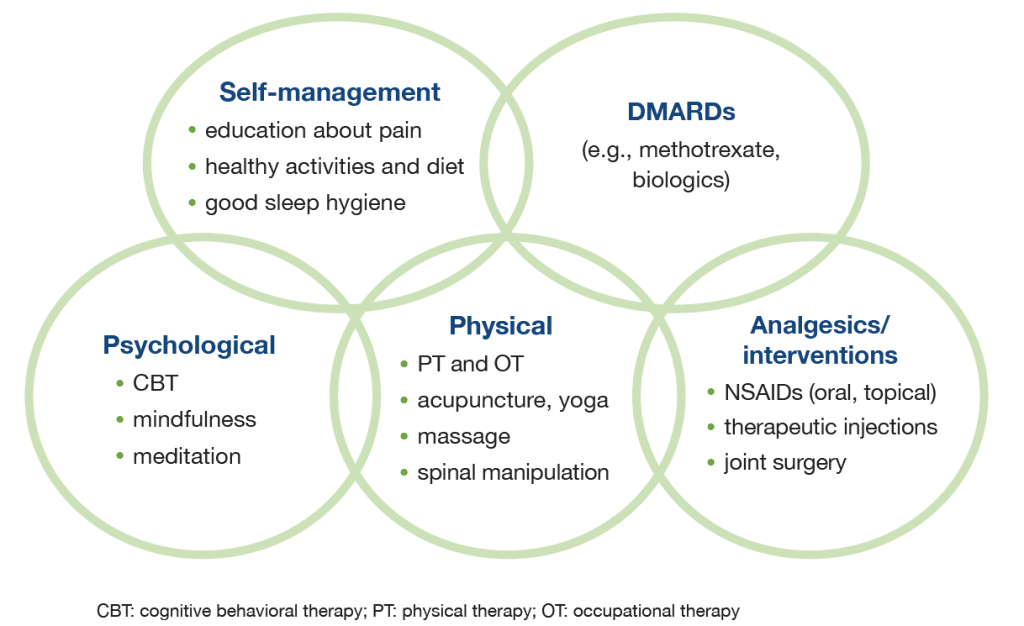Evidence-based Clinical Guidelines for Rheumatoid Arthritis
Published Materials
Rheumatoid arthritis (RA) is a chronic, autoimmune, systemic inflammatory condition with inflammatory arthritis as its primary manifestation.1 The overall goals of treatment are to control inflammation in order to decrease disease activity, to improve function, and to manage pain.
The treat-to-target approach for patients with RA2
This module focuses two of the three pillars of management: the selection of evidence-based, non-pharmacologic and non-opioid pharmacologic treatment options to help alleviate pain and improve function in patients with RA and related conditions. Specific DMARD selection is beyond the scope of this module.
Patients with RA often rate pain as their most important symptom.3 Pain can also persist even among patients who have achieved inflammatory remission. Creating a pain management strategy from among a variety of evidence-based options can help.
A multi-modal approach to pain management in RA4
While opioids are not generally recommended to manage pain, for patients who require a trial of an opioid medication, ensuring safety is critical. These steps are recommended for all patients taking opioids:5
- Explain to patients that opioids do not treat disease activity
- Check the prescription drug monitoring program
- Establish a plan for opioid use
- Routinely assess the risk and benefits of opioid use
- Use caution when escalating doses above 50 mg morphine equivalents per day
- Continue to optimize non-opioid treatment options
- Reduce risk of misuse by recommending naloxone and talking about safe storage and disposal
Resources for Providers
- Clinical Disease Activity Index (CDAI)
- Disease Activity Score (DAS)-28
- Opioid Dose Calculator
- Opioid Toxicology Tools
Resources for Patients
Information current at time of publication, May 2023.
The content of this website is educational in nature and includes general recommendations only; specific clinical decisions should only be made by a treating clinician based on the individual patient’s clinical condition.
References
- Sparks JA. Rheumatoid arthritis. Ann Intern Med. 2019;170(1):ITC1-ITC16.
- Geenen R, Overman CL, Christensen R, et al. EULAR recommendations for the health professional’s approach to pain management in inflammatory arthritis and osteoarthritis. Ann Rheum Dis. Jun 2018;77(6):797-807.
- Heiberg T, Kvien TK. Preferences for improved health examined in 1,024 patients with rheumatoid arthritis: Pain has highest priority. Arthritis Rheum. 2002;47(4):391-397.
- Flynn DM. Chronic Musculoskeletal Pain: Nonpharmacologic, Noninvasive Treatments. Am Fam Physician. Oct 15 2020;102(8):465-477.
- Dowell D, Ragan KR, Jones CM, et al. CDC Clinical Practice Guideline for Prescribing Opioids for Pain—United States, 2022. MMWR Recomm Rep. Nov 4 2022;71(3):1-95.

